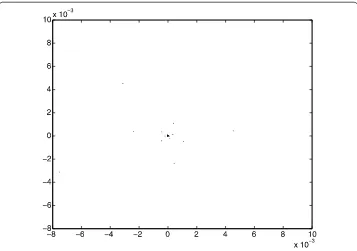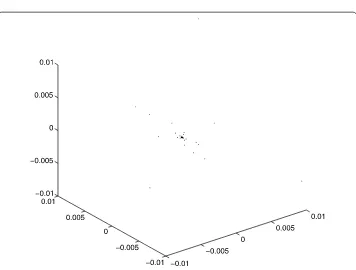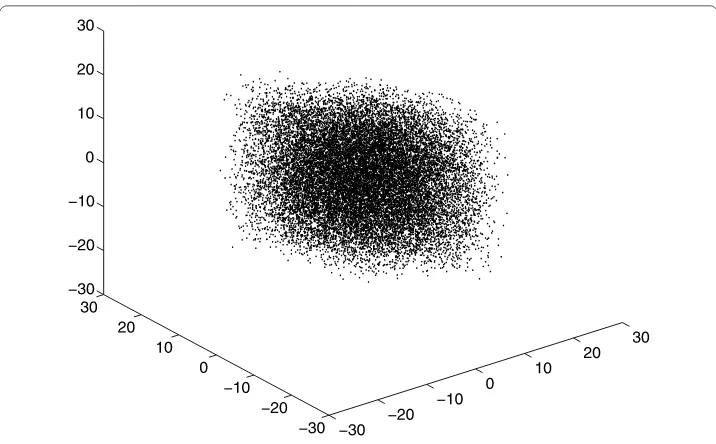R E S E A R C H
Open Access
Chaotification for linear delay difference
equations
Zongcheng Li
**Correspondence:
lizongcheng_0905@yahoo.com.cn Department of Mathematics, Shandong Jianzhu University, Jinan, Shandong 250101, P.R. China
Abstract
This paper is concerned with chaotification of linear delay difference equations via the feedback control technique. The controlled system is first reformulated into a linear discrete dynamical system. Then, a chaotification theorem based on the snap-back repeller theory for maps is established. The controlled system is proved to be chaotic in the sense of both Devaney an Li-Yorke. An illustrative example is provided with computer simulations.
MSC: 34C28; 37D45; 74H65
Keywords: chaos; chaotification; delay difference equation; chaos in the sense of Li-Yorke; chaos in the sense of Devaney
1 Introduction
Chaotification (or called anticontrol of chaos) is a process that makes a nonchaotic system chaotic, or enhances a chaotic system to present stronger or different type of chaos. In re-cent years, it has been found that chaos can actually be useful under some circumstances, for example, in human brain analysis [, ], heartbeat regulation [, ], encryption [], digital communications [],etc.So, sometimes it is useful and even important to make a system chaotic or create new types of chaos. It has attracted increasing interest in research on chaotification of dynamical systems due to the great potentials of chaos in many non-traditional applications.
In the pursuit of chaotifying discrete dynamical systems, a simple yet mathematically rigorous chaotification method was first developed by Chen and Lai [–] from a feed-back control approach. They showed that the Lyapunov exponents of a controlled system are positive [], and the controlled system via the mod-operation is chaotic in the sense of Devaney when the original system is linear and is chaotic in a weaker sense of Wiggins when the original system is nonlinear []. Later, Wang and Chen [] further showed that the Chen-Lai algorithm for chaotification also leads to chaos in the sense of Li-Yorke. This method plays an important role in studying chaotification problems of discrete dynamical systems. Recently, Shi and Chen [] studied chaotification for some discrete dynamical systems governed by continuous maps and showed that the controlled systems are chaotic in the sense of both Devaney and Li-Yorke. It is noticed that all the above chaotification problems for discrete dynamical systems are formulated in finite-dimensional real spaces. More recently, Shiet al.[] first studied chaotification for discrete dynamical systems in Banach spaces via the feedback control technique. They showed that some controlled systems in finite-dimensional real spaces studied by [] and [] are chaotic in the sense of
Devaney as well as in the sense of both Li-Yorke and Wiggins. Particularly, they extended and proved the Marotto theorem to general Banach spaces [], established some chaoti-fication theorems for discrete dynamical systems in (infinite-dimensional) Banach spaces [], and showed the controlled systems are chaotic in the sense of both Devaney and Li-Yorke. The reader is referred to Chen and Shi [] for a survey of chaotification of discrete dynamical systems and some references cited therein.
Time delay arises in many realistic systems with feedback in science and engineering. The delay difference equations have been studied by many researchers. Although there exist some general chaotification schemes for finite-dimensional or infinite-dimensional discrete dynamical systems as stated in the above, there are few results on the chaotifica-tion of linear delay difference equachaotifica-tions. In this paper, we employ the Chen-Lai method, from the feedback control approach to study chaotification of linear delay difference equa-tions and prove that the controlled system is chaotic in the sense of both Devaney and Li-Yorke by applying the snap-back repeller theory; see [, , ] for the theory.
The rest of the paper is organized as follows. In Section , the chaotification problem under investigation is described, and some concepts, one lemma, and reformulation of the controlled system are introduced. In Section , the chaotification problem is studied and a chaotification criterion is established. Finally, we provide an example to illustrate the theoretical result with computer simulations in Section .
2 Preliminaries
In this section, we describe the chaotification problem, give a reformulation of the linear delay difference equation, and introduce some fundamental concepts and a criterion of chaos, which will be used in the next section.
2.1 Description of chaotification problem
Consider the following linear delay difference equation:
x(n+ ) =
k+
j=
ajx(n+j–k– ), n≥, ()
wherek≥ is a fixed integer andaj, ≤j≤k+ , are constant parameters.
The object is to design a simple control input sequence{v(n)}such that the output of the controlled system
x(n+ ) =
k+
j=
ajx(n+j–k– ) +v(n), n≥, ()
is chaotic in the sense of both Devaney and Li-Yorke (see Definitions and below). The controller to be designed in this paper is in the form of
v(n) =βsin k+
j=
γjx(n+j–k– )
, ()
2.2 Reformulation
In this subsection, we reformulate equations () and () intok+ -dimensional discrete dynamical systems. By setting
uj(n) :=x(n+j–k– ), ≤j≤k+ ,n≥,
equation () and the controlled system () with controller () can be written as the follow-ing discrete systems onRk+:
u(n+ ) =Au(n), n≥, ()
Systems () and () are said to be induced by equations () and (), respectively. It is easy to see that the dynamical behaviors of equations () and () are the same as those of their induced systems () and (), respectively.
2.3 Some concepts and a criterion of chaos
Since Li and Yorke [] first introduced a precise mathematical definition of chaos, there appeared several different definitions of chaos, some are stronger and some are weaker, depending on the requirements in different problems; see [–]etc.For convenience, we list two definitions of chaos in the sense of Li-Yorke and Devaney, which are used in the paper.
Definition Let (X,d) be a metric space,f:X→Xbe a map, andSbe a set ofXwith at least two distinct points. ThenSis called a scrambled set offif for any two distinct points
x,y∈S,
Definition [] Let (X,d) be a metric space. A mapf :V⊂X→Vis said to be chaotic onVin the sense of Devaney if
(i) the set of the periodic points off is dense inV; (ii) f is topologically transitive inV;
(iii) f has sensitive dependence on initial conditions inV.
In , Bankset al.[] proved that conditions (i) and (ii) together imply condition (iii) iff is continuous inV. So, condition (iii) is redundant in the above definition in this case. It has been proved in [] that under some conditions, chaos in the sense of Devaney is stronger than that in the sense of Li-Yorke.
Now, we introduce some relative concepts for system (), which are motivated by [, Definitions . and .].
Definition
(i) A pointx∈Rk+is called anm-periodic point of system () ifx∈Rk+is an m-periodic point of its induced system (), that is,Fm(x) =x,Fj(x)=x,
≤j≤m– . In the special case ofm= ,xis called a fixed point or a steady state of system ().
(ii) The concepts of density of periodic points, topological transitivity, sensitive dependence on initial conditions, and the invariant set for system () are defined similarly to those for its induced system () inRk+.
(iii) System () is said to be chaotic in the sense of Devaney (or Li-Yorke) onV⊂Rk+if
its induced system () is chaotic in the sense of Devaney (or Li-Yorke) onV⊂Rk+.
In this paper, we will use the criterion of chaos established by Shiet al.to chaotify the linear delay difference equation (). For convenience, we state it as follows.
Lemma ([, Theorem .], [, Theorem .]) Let f :Rn→Rnbe a map with a fixed point z∈Rn.Assume that
(i) f is continuously differentiable in a neighborhood ofzand all the eigenvalues ofDf(z)
have absolute values larger than,which implies that there exist a positive constantr and a norm · inRnsuch thatf is expanding inB¯r(z)in · ,whereB¯r(z)is the closed ball of radiusrcentered atzin(Rn, · );
(ii) zis a snap-back repeller off withfm(x
) =z,x=z,for somex∈Br(z)and some positive integerm,whereBr(z)is the open ball of radiusrcentered atzin(Rn, · ). Furthermore,f is continuously differentiable in some neighborhoods of
x,x, . . . ,xm–,respectively,anddetDf(xj)= for≤j≤m– ,wherexj=f(xj–)for
≤j≤m– .
Then for each neighborhood U of z,there exist a positive integer k>m and a Cantor set
⊂U such that fk:→is topologically conjugate to the symbolic dynamical system
σ :+ →+. Consequently,there exists a compact and perfect invariant set V ⊂Rn,
containing the Cantor set,such that f is chaotic on V in the sense of Devaney as well as in the sense of Li-Yorke,and has a dense orbit in V.
can be briefly stated as follows: ‘a regular and nondegenerate snap-back repeller in Rn
implies chaos in the sense of both Devaney and Li-Yorke’. We refer to [, ] for de-tails.
3 Chaotification for linear delay difference equations
In this section, we will show that the controlled system () with a single-input state feed-back controller (),i.e., the controlled system () with controller (), is chaotic in the sense of both Devaney and Li-Yorke for some parametersβandγj, ≤j≤k.
In the following, we only show the fixed point Ocan be a regular and nondegenerate snap-back repeller of system () under some conditions.
Theorem There exist some constantsβ> andγj, ≤j≤k,with
such that the controlled system(),and consequently system(),is chaotic in the sense of both Devaney and Li-Yorke.
Proof We will use Lemma to prove this theorem. So, it suffices to show that all the con-ditions in Lemma are satisfied. As assumed in the statement of the theorem, letβand
|γ|satisfy condition () throughout the proof.
First, we will show thatOis an expanding fixed point ofFin some norm inRk+. In fact, Fis continuously differentiable inRk+, and the Jacobian matrix ofFatOis
DF(O) =
Its eigenvalues are determined by
λk+– (βγk++ak+)λk– (βγk+ak)λk––· · ·– (βγ+a)λ– (βγ+a) = . ()
eigen-valueλofDF(O) with|λ| ≤, then we get the following inequality:
which is a contradiction. Hence, it follows from the first condition of Lemma , there exist a positive constantrand a norm · *inRk+such thatOis an expanding fixed point ofF
can become very small. So, the distance of the fixed pointsOandPcan be very small, and consequently, therobtained above will be less than .
Next, we showOis a snap-back repeller ofFin the norm · *. For fixeda
follows from the first relation of () that|aj
β|< , ≤j≤k+ . Let
which implies thatOis a snap-back repeller ofF. Finally, we show that
A direct calculation shows that for anyu= (u, . . . ,uk+)T∈Rk+,
can be carried out from equations () and () by choosing sufficiently largeβ. Therefore, all the assumptions in Lemma are satisfied andOis a regular and nondegenerate snap-back repeller of system (). So, system (),i.e., equation (), is chaotic in the sense of both
Devaney and Li-Yorke. The proof is complete.
Remark Zhang and Chen [], Kwok and Tang [] had independently studied the chaotification of system () with the following single-input controllers:
bv(n) = –bsin
rameters. They showed that the controlled system is chaotic in the sense of Li-Yorke by using the Marotto theorem. However, there exists some problem in their proofs. We state as follows. By the definition of a snap-back repeller, if a pointzis a snap-back repeller of a mapg, thenzis an expanding fixed point ofginB¯r(z) for somer> , and there exists a
pointx∈Br(z) withx= zsuch thatgm(x) =zfor some positive integerm. It is easy to
show that there must exist a positive integerm<msuch thatgm(x) /∈Br(z). However,
in the proofs of both [] and [], they all proved that the mapg of the controlled sys-tem is expanding in a neighborhoodBr(O) of the originO∈Rk+, and there exists a point x∈Br(O) such thatg(x)∈Br(O) andg(x) =O, and consequentlyOis a snap-back
re-peller of the mapg. This is a contradiction with the definition of a snap-back repeller. In this paper, we use controller () to chaotify the linear delay system (), which corresponds to the chaotification of linear system () with the following single-input controller:
bv(n) =bβsin
4 An example
In the last section, we present an example of chaotification for a linear delay difference equation with computer simulations.
Example The linear delay difference equation () is taken as the following:
x(n+ ) = –
k+
j=
jx(n+j–k– ), n≥, ()
wherek≥ is a fixed integer.
Obviously,O= (, , . . . , )T∈Rk+is a fixed point of equation (). By Theorem , we
can take controller () withβandγj, ≤j≤k+ , as specified in the proof, such that the
output of the controlled system (),i.e., system (), is chaotic in the sense of both Devaney and Li-Yorke. In order to help better visualize the theoretical result, we takek= , for computer simulations. Fork= , we can take
β= , γ= π+arcsin
, γ=arcsin .
Fork= , we take
β= , γ= π+arcsin
, γ=arcsin
, γ=arcsin .
Both of them satisfy the condition (). The simulated results show that the origin system (),i.e., system (), has simple dynamical behaviors, and the controlled system (),i.e., system (), has complex dynamical behaviors, see Figures -.
Figure 2 2-D computer simulation result shows complex dynamical behaviors of the controlled system (5) in the (u1,u2) space fork= 1,β= 10,γ1= 2π+ arcsin201,γ2= arcsin401.
Figure 4 3-D computer simulation result shows complex dynamical behaviors of the controlled system (5) in the (u1,u2,u3) space fork= 2,β= 10,γ1= 2π+ arcsin201,γ2= arcsin401,γ3= arcsin601.
Competing interests
The author declares that he has no competing interests.
Acknowledgements
This work is supported by National Natural Science Foundation of China (Grant 11101246).
Received: 2 August 2012 Accepted: 22 February 2013 Published: 18 March 2013
References
1. Freeman, WJ: Chaos in the brain: possible roles in biological intelligence. Int. J. Intell. Syst.10, 71-88 (1995) 2. Schiff, SJ, Jerger, K, Duong, DH, Chang, T, Spano, ML, Ditto, WL: Controlling chaos in the brain. Nature370, 615-620
(1994)
3. Brandt, ME, Chen, GR: Bifurcation control of two nonlinear of models of cardiac activity. IEEE Trans. Circuits Syst. I44, 1031-1034 (1997)
4. Ditto, WL, Spano, ML, Nelf, J, Meadows, B, Langberg, JJ, Bolmann, A, McTeague, K: Control of human atrial fibrillation. Int. J. Bifurc. Chaos10, 593-602 (2000)
5. Jakimoski, G, Kocarev, LG: Chaos and cryptography: block encryption ciphers based on chaotic maps. IEEE Trans. Circuits Syst. I48, 163-169 (2001)
6. Kocarev, LG, Maggio, M, Ogorzalek, M, Pecora, L, Yao, K: Special issue on applications of chaos in modern communication systems. IEEE Trans. Circuits Syst. I48, 1385-1527 (2001)
7. Chen, GR, Lai, DJ: Feedback control of Lyapunov exponents for discrete-time dynamical systems. Int. J. Bifurc. Chaos
6, 1341-1349 (1996)
8. Chen, GR, Lai, DJ: Anticontrol of chaos via feedback. In: Proc. of IEEE Conference on Decision and Control, San Diego, CA, Dec, pp. 367-372 (1997)
9. Chen, GR, Lai, DJ: Feedback anticontrol of discrete chaos. Int. J. Bifurc. Chaos8, 1585-1590 (1998) 10. Wang, XF, Chen, GR: On feedback anticontrol of discrete chaos. Int. J. Bifurc. Chaos9, 1435-1441 (1999)
11. Shi, YM, Chen, GR: Chaotification of discrete dynamical systems governed by continuous maps. Int. J. Bifurc. Chaos
15, 547-556 (2005)
12. Shi, YM, Yu, P, Chen, GR: Chaotification of dynamical systems in Banach spaces. Int. J. Bifurc. Chaos16, 2615-2636 (2006)
13. Wang, XF, Chen, GR: Chaotification via arbitrary small feedback controls. Int. J. Bifurc. Chaos10, 549-570 (2000) 14. Shi, YM, Chen, GR: Discrete chaos in Banach spaces. Sci. China Ser. A34, 595-609 (2004). English version:48, 222-238
(2005)
15. Chen, GR, Shi, YM: Introduction to anti-control of discrete chaos: theory and applications. Philos. Trans. R. Soc. Lond. A
364, 2433-2447 (2006)
16. Shi, YM, Chen, GR: Chaos of discrete dynamical systems in complete metric spaces. Chaos Solitons Fractals22, 555-571 (2004)
17. Marotto, FR: Snap-back repellers imply chaos inRn. J. Math. Anal. Appl.63, 199-223 (1978)
18. Li, TY, Yorke, JA: Period three implies chaos. Am. Math. Mon.82, 985-992 (1975)
19. Devaney, RL: An Introduction to Chaotic Dynamical Systems. Addison-Wesley, New York (1987) 20. Martelli, M, Dang, M, Steph, T: Defining chaos. Math. Mag.71, 112-122 (1998)
22. Wiggins, S: Global Bifurcations and Chaos. Springer, New York (1988)
23. Banks, J, Brooks, J, Cairns, G, Davis, G, Stacey, P: On Devaney’s definition of chaos. Am. Math. Mon.99, 332-334 (1992) 24. Huang, W, Ye, XD: Devaney’s chaos or 2-scattering implies Li-Yorke’s chaos. Topol. Appl.117, 259-272 (2002) 25. Zhang, HZ, Chen, GR: Single-input multi-output state-feedback chaotification of general discrete systems. Int.
J. Bifurc. Chaos14, 3317-3323 (2004)
26. Kwok, HS, Tang, WKS: Chaotification of discrete-time systems using neurons. Int. J. Bifurc. Chaos14, 1405-1411 (2004)
doi:10.1186/1687-1847-2013-59
Cite this article as:Li:Chaotification for linear delay difference equations.Advances in Difference Equations2013


